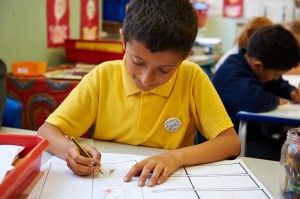


Mathematics
“Mathematics is essential to everyday life. A high quality mathematics education provides a foundation for understanding the world, the ability to reason mathematically, an appreciation of the beauty and power of mathematics, and a sense of enjoyment and curiosity about the subject.” 2014 National Curriculum

Mathematics is a fundamental part of everyday life and so at Sherington we aim to develop enthusiastic and confident learners. Mathematics teaches us how to make sense of the world around us through developing the pupils’ ability to calculate, to reason and to solve problems. It enables children to understand and appreciate relationships and patterns in both number and space in their everyday lives and the world around them.
Daily mathematic lessons aim to:
At Sherington, we have embraced the Maths No Problem scheme which follows a CPA approach. Concrete, Pictorial, Abstract (CPA) is a highly effective approach to teaching that develops a deep and sustainable understanding of maths in pupils. The CPA approach builds on children’s existing knowledge by introducing abstract concepts in a concrete and tangible way. It involves moving from concrete materials, to pictorial representations, to abstract symbols and problems. Concrete is the “doing” stage. During this stage, students use concrete objects to model problems. Unlike traditional maths teaching methods where teachers demonstrate how to solve a problem, the CPA approach brings concepts to life by allowing children to experience and handle physical (concrete) objects. With the CPA framework, every abstract concept is first introduced using physical, interactive concrete materials. Pictorial is the “seeing” stage. Here, visual representations of concrete objects are used to model problems. This stage encourages children to make a mental connection between the physical object they just handled and the abstract pictures, diagrams or models that represent the objects from the problem. Abstract is the “symbolic” stage, where children use abstract symbols to model problems. Students will not progress to this stage until they have demonstrated that they have a solid understanding of the concrete and pictorial stages of the problem. The abstract stage involves the teacher introducing abstract concepts (for example, mathematical symbols). Children are introduced to the concept at a symbolic level, using only numbers, notation, and mathematical symbols (for example, +, –, x, /) to indicate addition, multiplication or division. The Maths No Problem approach encourages teachers to vary the apparatus that children use in class. For example, students might one day use counters, another day they might use a ten frame. Likewise, children are encouraged to represent the day’s maths problem in a variety of ways. For example, drawing an array, a number bond diagram or a bar model. By systematically varying the apparatus and methods used to solve a problem, children can craft powerful mental connections between the concrete, pictorial, and abstract phases. It is important to recognise that the CPA model is a progression. By the end of KS1, children need to be able to go beyond the use of concrete equipment to access learning using either pictorial representations or abstract understanding. What is important, therefore, is that all learners, however young, can see the connections between each representation.
When teaching maths for mastery, the whole class moves through topics at broadly the same pace. Each topic is studied in depth and the teacher does not move to the next stage until all children demonstrate that they have a secure understanding of mathematical concepts. In a traditional primary school maths lesson, children are put in different groups and given different content based on their anticipated ability. This means that from an early age children are classed as those who can and can’t “do maths”. Teaching maths for mastery is different because it offers all pupils access to the full maths curriculum. This inclusive approach, and its emphasis on promoting multiple methods of solving a problem, builds self-confidence and resilience in pupils. Though the whole class goes through the same content at the same pace, there is still plenty of opportunity for differentiation. Unlike the old model, where advanced learners are accelerated through new content, those pupils who grasp concepts quickly are challenged with rich and sophisticated problems within the topic. Those children who are not sufficiently fluent are provided additional support to consolidate their understanding before moving on.